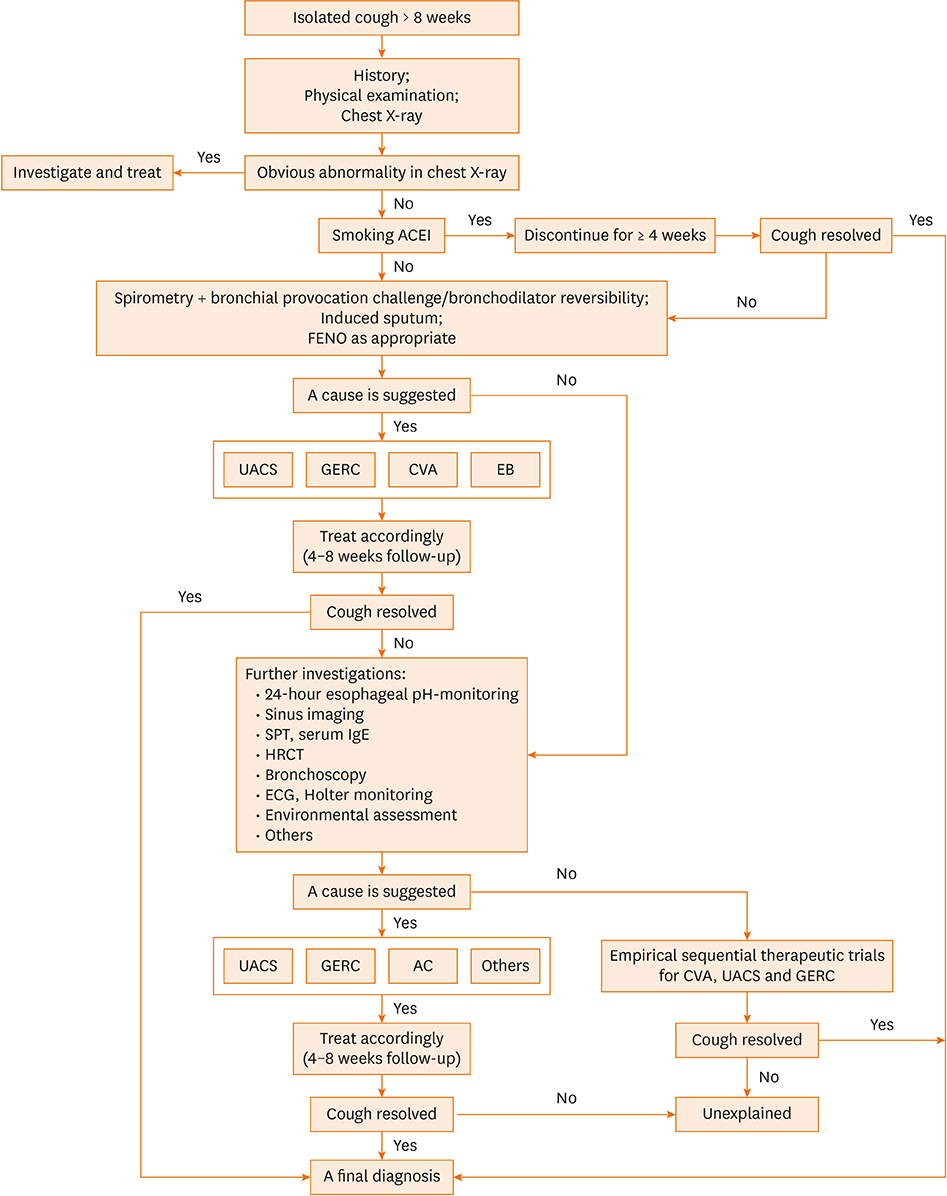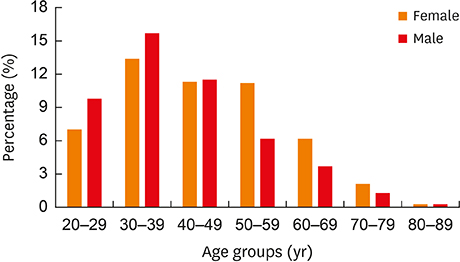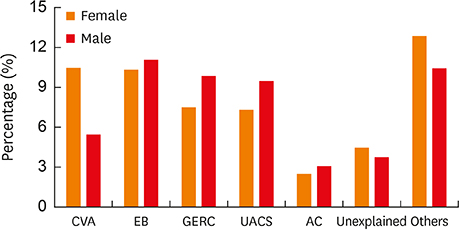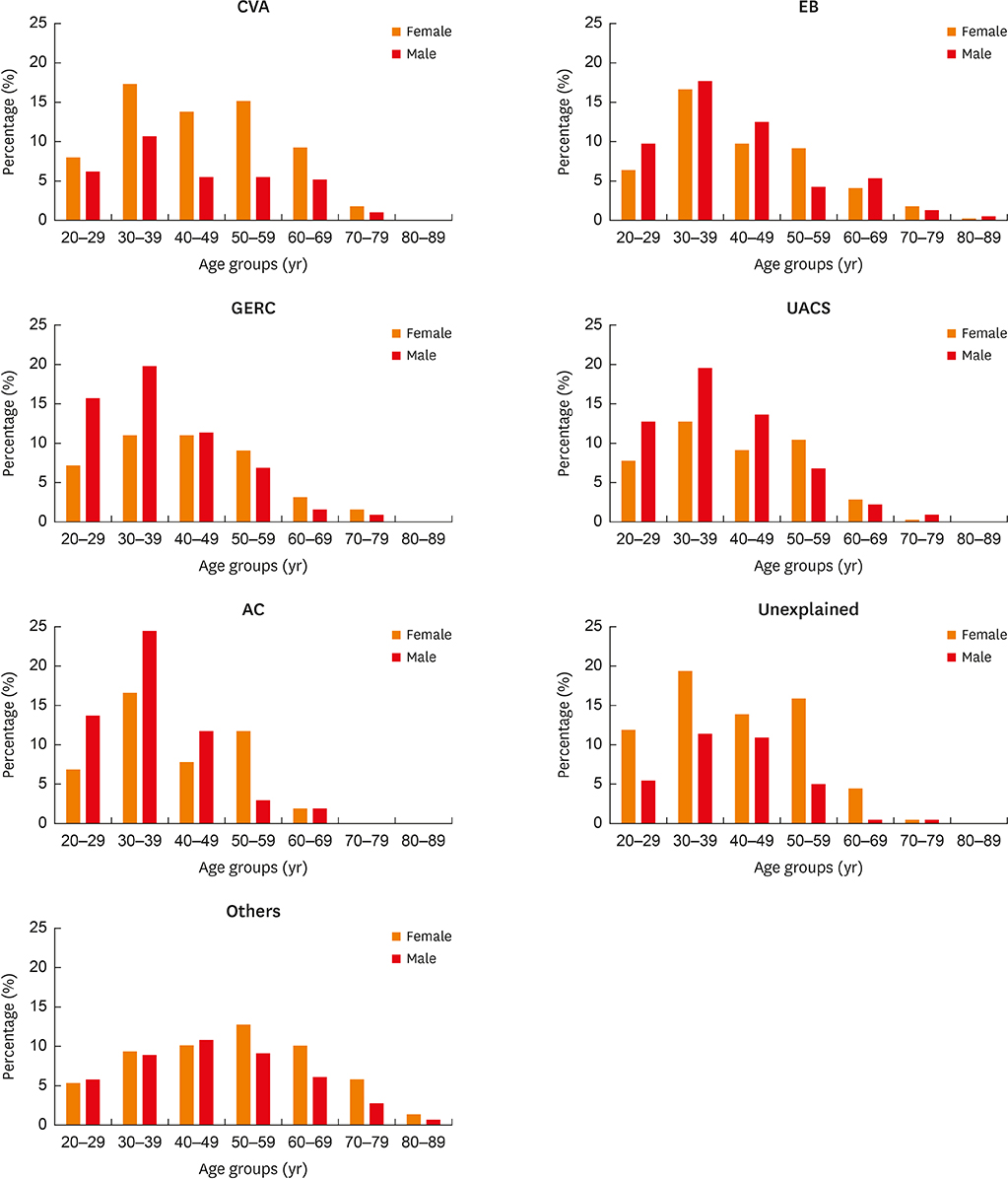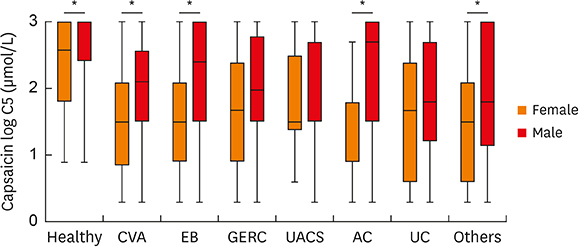Allergy Asthma Immunol Res.
2019 Nov;11(6):871-884. 10.4168/aair.2019.11.6.871.
Age and Sex Distribution of Chinese Chronic Cough Patients and Their Relationship With Capsaicin Cough Sensitivity
- Affiliations
-
- 1State Key Laboratory of Respiratory Disease, National Clinical Research Center for Respiratory Disease, Guangzhou Institute of Respiratory Health, The First Affiliated Hospital of Guangzhou Medical University, Guangzhou, China. klai@163.com
- 2National Heart and Lung Institute, Imperial College London, Royal Brompton and Harefield Foundation NHS Trust, London, UK.
- KMID: 2459190
- DOI: http://doi.org/10.4168/aair.2019.11.6.871
Abstract
- PURPOSE
An older female predominance has been reported among chronic cough patients in Western countries, which is considered to be associated with a higher cough sensitivity in females. However, the characteristics of Chinese chronic cough patients remain unclear. This study aimed to explore the age and sex distribution as well as their relationship with cough reflex sensitivity to capsaicin in Chinese chronic cough patients.
METHODS
We analyzed the demographic features of 1,882 consecutive chronic cough patients who attended our cough clinic in Guangzhou, China. Cough sensitivity to capsaicin, which was defined as the lowest concentration of capsaicin causing 5 coughs or more (C5), was measured in 539 of the 1,882 patients and 68 healthy volunteers.
RESULTS
The mean age of the patients was 43.0 ± 13.7 years and patients aged <50 years accounted for more than two-thirds of the study population. Around 87% of the patients were never-smokers. The proportion of females (51.5%) was almost equal to that of males (48.5%). The pattern of the age and sex distribution was consistently reflected within most common causes of chronic cough, while a female predominance was shown in patients with cough-variant asthma and patients aged ≥50 years. Female patients had higher cough sensitivity to capsaicin than male patients (log C5: 1.58 ± 0.84 vs. 2.04 ± 0.84 μmol/L, P = 0.001), and patients aged ≥50 years had higher cough sensitivity to capsaicin than patients aged <50 years.
CONCLUSIONS
In China, patients with chronic cough have a roughly equal sex distribution and a middle-aged predominance, irrespective of a higher cough sensitivity to capsaicin in females and older patients. TRIAL REGISTRATION: ClinicalTrials.gov Identifier: NCT02591550
Keyword
MeSH Terms
Figure
Reference
-
1. Song WJ, Chang YS, Faruqi S, Kim JY, Kang MG, Kim S, et al. The global epidemiology of chronic cough in adults: a systematic review and meta-analysis. Eur Respir J. 2015; 45:1479–1481.
Article2. Lai K, Chen R, Lin J, Huang K, Shen H, Kong L, et al. A prospective, multicenter survey on causes of chronic cough in China. Chest. 2013; 143:613–620.
Article3. Morice AH, Fontana GA, Sovijarvi AR, Pistolesi M, Chung KF, Widdicombe J, et al. The diagnosis and management of chronic cough. Eur Respir J. 2004; 24:481–492.
Article4. Chung KF, Pavord ID. Prevalence, pathogenesis, and causes of chronic cough. Lancet. 2008; 371:1364–1374.
Article5. Young EC, Smith JA. Quality of life in patients with chronic cough. Ther Adv Respir Dis. 2010; 4:49–55.
Article6. French CL, Irwin RS, Curley FJ, Krikorian CJ. Impact of chronic cough on quality of life. Arch Intern Med. 1998; 158:1657–1661.
Article7. Dicpinigaitis PV, Tso R, Banauch G. Prevalence of depressive symptoms among patients with chronic cough. Chest. 2006; 130:1839–1843.
Article8. Chamberlain SA, Garrod R, Douiri A, Masefield S, Powell P, Bücher C, et al. The impact of chronic cough: a cross-sectional European survey. Lung. 2015; 193:401–408.
Article9. Kavalcikova-Bogdanova N, Buday T, Plevkova J, Song WJ. Chronic cough as a female gender issue. Adv Exp Med Biol. 2016; 905:69–78.10. Morice AH, Jakes AD, Faruqi S, Birring SS, McGarvey L, Canning B, et al. A worldwide survey of chronic cough: a manifestation of enhanced somatosensory response. Eur Respir J. 2014; 44:1149–1155.
Article11. Song WJ, Kim JY, Jo EJ, Lee SE, Kim MH, Yang MS, et al. Capsaicin cough sensitivity is related to the older female predominant feature in chronic cough patients. Allergy Asthma Immunol Res. 2014; 6:401–408.
Article12. Kastelik JA, Thompson RH, Aziz I, Ojoo JC, Redington AE, Morice AH. Sex-related differences in cough reflex sensitivity in patients with chronic cough. Am J Respir Crit Care Med. 2002; 166:961–964.
Article13. Fujimura M, Kasahara K, Kamio Y, Naruse M, Hashimoto T, Matsuda T. Female gender as a determinant of cough threshold to inhaled capsaicin. Eur Respir J. 1996; 9:1624–1626.
Article14. Yi F, Chen R, Luo W, Xu D, Han L, Liu B, et al. Validity of fractional exhaled nitric oxide in diagnosis of corticosteroid-responsive cough. Chest. 2016; 149:1042–1051.
Article15. Morice AH, McGarvey L, Pavord I. British Thoracic Society Cough Guideline Group. Recommendations for the management of cough in adults. Thorax. 2006; 61:Suppl 1. i1–i24.
Article16. Irwin RS, Madison JM. The diagnosis and treatment of cough. N Engl J Med. 2000; 343:1715–1721.
Article17. Long L, Yao H, Tian J, Luo W, Yu X, Yi F, et al. Heterogeneity of cough hypersensitivity mediated by TRPV1 and TRPA1 in patients with chronic refractory cough. Respir Res. 2019; 20:112.
Article18. Morice AH, Kastelik JA. Cough. 1: chronic cough in adults. Thorax. 2003; 58:901–907.19. Chang AB, Widdicombe JG. Cough throughout life: children, adults and the senile. Pulm Pharmacol Ther. 2007; 20:371–382.
Article20. Çolak Y, Nordestgaard BG, Laursen LC, Afzal S, Lange P, Dahl M. Risk factors for chronic cough among 14,669 individuals from the general population. Chest. 2017; 152:563–573.
Article21. Dicpinigaitis PV. Thoughts on one thousand chronic cough patients. Lung. 2012; 190:593–596.
Article22. Jorm LR, Shepherd LC, Rogers KD, Blyth FM. Smoking and use of primary care services: findings from a population-based cohort study linked with administrative claims data. BMC Health Serv Res. 2012; 12:263.
Article23. Kastelik JA, Aziz I, Ojoo JC, Thompson RH, Redington AE, Morice AH. Investigation and management of chronic cough using a probability-based algorithm. Eur Respir J. 2005; 25:235–243.
Article24. Kelsall A, Decalmer S, McGuinness K, Woodcock A, Smith JA. Sex differences and predictors of objective cough frequency in chronic cough. Thorax. 2009; 64:393–398.
Article25. Niimi A, Ohbayashi H, Sagara H, Yamauchi K, Akiyama K, Takahashi K, et al. Cough variant and cough-predominant asthma are major causes of persistent cough: a multicenter study in Japan. J Asthma. 2013; 50:932–937.
Article26. Fujimura M, Abo M, Ogawa H, Nishi K, Kibe Y, Hirose T, et al. Importance of atopic cough, cough variant asthma and sinobronchial syndrome as causes of chronic cough in the Hokuriku area of Japan. Respirology. 2005; 10:201–207.
Article27. Dicpinigaitis PV, Allusson VR, Baldanti A, Nalamati JR. Ethnic and gender differences in cough reflex sensitivity. Respiration. 2001; 68:480–482.
Article28. Guan WJ, Zheng XY, Chung KF, Zhong NS. Impact of air pollution on the burden of chronic respiratory diseases in China: time for urgent action. Lancet. 2016; 388:1939–1951.
Article29. Sato R, Gui P, Ito K, Kohzuki M, Ebihara S. Effect of short-term exposure to high particulate levels on cough reflex sensitivity in healthy tourists: a pilot study. Open Respir Med J. 2016; 10:96–104.
Article30. Fang Z, Huang C, Zhang JJ, Xie J, Dai S, Ge E, et al. Traffic-related air pollution induces non-allergic eosinophilic airway inflammation and cough hypersensitivity in guinea-pigs. Clin Exp Allergy. 2019; 49:366–377.
Article31. Lin J, Wang H, Yan F, Tang K, Zhu H, Weng Z, et al. Effects of occupational exposure to noise and dust on blood pressure in Chinese industrial workers. Clin Exp Hypertens. 2018; 40:257–261.
Article32. Tang YX, Bloom MS, Qian ZM, Liu E, Jansson DR, Vaughn MG, et al. Association between ambient air pollution and hyperuricemia in traffic police officers in China: a cohort study. Int J Environ Health Res. 2019; 1–9.
Article33. Feng Z, Zhan J, Wang C, Ma C, Huang Z. The association between musculoskeletal disorders and driver behaviors among professional drivers in China. Int J Occup Saf Ergon. 2018; 1–11.
Article34. Wu X, Zhang H, Xiao W, Ning P, Schwebel DC, Hu G. Are bus company regulations associated with crash risk? Findings from a retrospective survey in four Chinese cities. Int J Environ Res Public Health. 2019; 16:E1342.
Article35. Bennett WD, Zeman KL, Kim C. Variability of fine particle deposition in healthy adults: effect of age and gender. Am J Respir Crit Care Med. 1996; 153:1641–1647.
Article36. Robinson RK, Birrell MA, Adcock JJ, Wortley MA, Dubuis ED, Chen S, et al. Mechanistic link between diesel exhaust particles and respiratory reflexes. J Allergy Clin Immunol. 2018; 141:1074–1084.e9.
Article37. Deering-Rice CE, Romero EG, Shapiro D, Hughen RW, Light AR, Yost GS, et al. Electrophilic components of diesel exhaust particles (DEP) activate transient receptor potential ankyrin-1 (TRPA1): a probable mechanism of acute pulmonary toxicity for DEP. Chem Res Toxicol. 2011; 24:950–959.
Article38. Feng-Jia C, Xin-Yan H, Geng-Peng L, Yang-Li L, Can-Mao X. Validity of fractional exhaled nitric oxide and small airway function indices in diagnosis of cough-variant asthma. J Asthma. 2018; 55:750–755.
Article39. Cao Y, Lin SH, Zhu D, Xu F, Chen ZH, Shen HH, et al. WeChat public account use improves clinical control of cough-variant asthma: a randomized controlled trial. Med Sci Monit. 2018; 24:1524–1532.
Article
- Full Text Links
- Actions
-
Cited
- CITED
-
- Close
- Share
- Similar articles
-
- Cough Sensitivity and Extrathoracic Airway Responsiveness to Inhaled Capsaicin in Chronic Cough Patients
- Clinical features and cough sensitivity of patients with idiopathic chronic cough
- Capsaicin cough sensitivity is related to the older female predominant feature in chronic cough patients
- Relationship of eosinophils in induced sputum with bronchial responsiveness to methacholine or capsaicin and with responses to anti-asthmatic treatment in chronic cough patients
- Airway disorders associated with chronic cough

